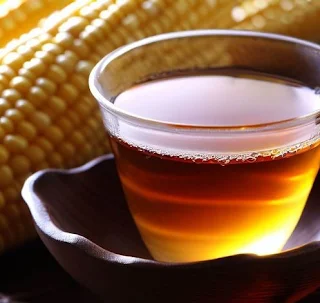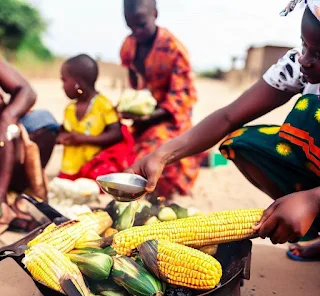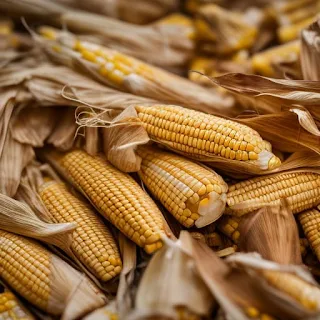Corn Husk Tea Ingredients and Directions
Corn tea is gaining popularity in Africa among health-conscious individuals and those seeking distinctive flavors and natural remedies.
 |
| Corn Husk Tea Ingredients and Directions. |
With its mild, slightly sweet taste and subtle corn-like aroma, corn tea provides a distinct alternative for those exploring diverse beverage options. In addition, as awareness spreads about its antioxidant properties and potential wellness attributes, corn tea is becoming a favored choice for African individuals who value holistic well-being and enjoy discovering new and intriguing flavors.
Corn is big business in Africa, and corn tea is emerging as a popular beverage choice among health-conscious individuals and those seeking unique flavors and organic remedies. Moreover, with the abundance of corn production in several African countries, the utilization of corn beyond traditional food applications is expanding.
The top corn-producing countries in Africa include South Africa, Nigeria, Ethiopia, and Tanzania; however, corn grows in 20 African countries. As awareness grows about corn tea's nutritional value and cultural significance, it presents opportunities for local entrepreneurs, agricultural diversification, and a connection to ancestral traditions associated with this versatile crop.
Corn has cultural significance in many African societies.
Corn has cultural significance in many African societies. It is used in traditional recipes, rituals, and celebrations, reflecting its deep-rooted presence in local customs and traditions. In addition, corn is often featured in conventional ways and ceremonies across Africa.
It is used as an offering to ancestors or deities, symbolizing fertility, abundance, and food. Corn plays a central role in harvest festivals and other celebrations, where it is used in decorations, dances, and communal meals. It is also a staple food in various African cuisines. It prepares porridge, bread, stews, snacks, and beverages.
Rituals and ceremonies associated with corn often occur during planting and harvest seasons. These events mark important milestones in the agricultural cycle and are celebrated to ensure a successful crop and express gratitude for the abundance received.
Harvest festivals are common in many African cultures. These festivities typically take place when the corn crop is ready for harvesting. They involve communal gatherings, songs, dances, and feasts around the corn harvest. People dress in traditional attire and create decorative displays using corn stalks, husks, and other corn-related elements.
Maize is Corn, and Corn is Maize.
Maize is commonly used in many English-speaking countries outside the United States, especially in scientific and agricultural contexts. The term corn has different meanings depending on the region. Corn is commonly used to refer to maize in the United States and Canada.
However, in other English-speaking countries, including the United Kingdom, Australia, and New Zealand, corn typically refers to what Americans call corn on the cob or sweet corn. The word corn in this context originally meant a small, hard grain or seed. Both terms, maize, and corn, ultimately refer to the same crop, the grain crop known scientifically as Zea mays.
Corn tea can be found in specialty tea stores or online retailers that offer a variety of herbal teas. Corn tea has a mild, slightly sweet taste with subtle herbal notes. It may impart a delicate corn-like aroma reminiscent of fresh corn on the cob.
Corn Husk Tea Ingredients and Directions.
 |
| Corn Husk Tea Ingredients and Directions. |
Ingredients
Water
Optional: sweetener (such as honey or sugar) to taste
Directions
Ensure that the corn husks are clean and free from any debris. If needed, gently rinse them under running water and pat them dry. Tear or cut the dried corn husks into smaller pieces to increase their surface area, which will help with the infusion process.
Bring a pot of water to a boil on the stove. Once the water is boiling, add the dried corn husk pieces to the bank. Use approximately 2 to 3 husks, depending on your desired strength and taste. Reduce the heat to low and let the tea simmer for 10 to 15 minutes. This will allow the flavors and beneficial compounds from the corn husks to infuse into the water.
After simmering, remove the pot from the heat. Using a fine-mesh sieve or tea strainer, strain the tea to remove the corn husk pieces. Taste the tea and add sweeteners like honey or sugar, if desired. Stir well until the sweetener is fully dissolved. Pour the corn husk tea into cups and savor its unique flavor. You can serve it hot or let it cool and enjoy it as a refreshing iced tea.
Dried corn husk tea has a mild, slightly sweet taste. However, it is often appreciated for its soothing properties and can be consumed for relaxation or as a caffeine-free alternative to traditional teas.
Remember to consult a healthcare professional if you have any specific health concerns or are taking medications that may interact with herbal teas.
Dried corn husks for Corn Tea can be purchased at grocery stores, online, and from local farmers.
Many well-stocked grocery stores or supermarkets carry dried corn husks in the international or ethnic food sections. Look for them in the aisle that features Latin American or Mexican ingredients.
Numerous online retailers and marketplaces offer dried corn husks for purchase. You can search for them on websites like Amazon, Walmart, or specialty food stores. Ensure to read reviews and check the seller's reputation before purchasing.
Local farmer's markets may sometimes have vendors selling dried corn husks. This can be an excellent opportunity to support local farmers and find high-quality, natural products.
When buying dried corn husks, consider their quality and ensure they are clean and free from any signs of mold or damage. It's also helpful to check the package or label for specific instructions or indications that they are food-grade.
Corn production in Africa is significant in several countries across the continent. Some of the top corn-producing countries include South Africa, Nigeria, Ethiopia, Tanzania, Kenya, Uganda, Malawi, Zambia, Zimbabwe, Mozambique, Ghana, Rwanda, Burkina Faso, Mali, Sudan, Cameroon, Ivory Coast, Senegal, Niger, and Togo.
These countries play a crucial role in meeting the demand for corn, a staple crop and a vital source of food security in many African regions. In addition, the varying climates, agricultural practices, and economic factors contribute to the diverse corn production landscape throughout Africa, supporting farmers' livelihoods, ensuring food availability, and contributing to the local and regional economies.





